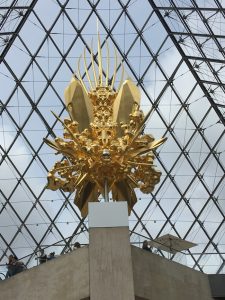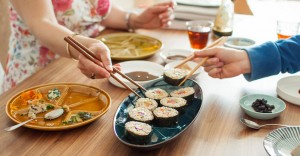France, Paris: The Throne in the Palace of the Louvre
Monday, January 7th, 2019.
France is celebrating 160th anniversary of diplomatic ties between France and Japan. Japonismes 2018: Les Ames en Resonance, will run through February 2019 involving exhibitions and events promoting Japanese art and design. Visual artist Kohei Nawa’s monumental sculpture “Throne” has one of the most prestigious spots in Paris: the Louvre. “I see the location as a connecting portal of modern lifestyles and the past, says Nawa, the Kyoto-based artist whose 10.4-meter-tall work is installed under I.M. Pei’s 1989 glass pyramid in the Louvre’s main courtyard.
The making of the throne itself involved both the past and the present. It was designed using state-of-the-art 3D modeling software and carved by robotic arms, however its gleaming gold leaf exterior was hand-applied by Japanese traditional craftspeople.
“The maximum capacity the pyramid can hold is 3 tons, so I told the museum I would ship a sculpture weighing exactly 3 tons,” says Nawa about the work’s creation. “I think they were bit worried, but after it went up, the Louvre’s curator, Martin Kiefer, told me the sculpture looks like it’s been at the pyramid all along.”
It’s not Nawa’s first “Throne” and it is different in that in previous iterations there was usually a small child seated within Nawa’s unique abstract shapes and geometric forms. For the Louvre, the seat is strikingly empty.
“Thrones are for kings. Here, the seat is for the authority that will eventually take over the control in the future. I left the seat empty to emphasize the invisibility,” says Nawa.
It sounds ominous, but Nawa goes on to explain that he foresees the type of power we see controlling today’s politics, economy and lifestyles as disappearing in the future, and in its place will be a very different form of authority. It could be artificial intelligence and advanced computer technology that will “take the throne,” he suggests, while we blindly follow, something that history has shown us that humans have had the tendency to do.
To us it is interesting that he chose a throne to be placed in this, the Palace of the Louvre, where French Kings sat on their thrones. Francis I chose this edifice as the residence for French kings and where it remained thus until good old King Louis XIV decided to move to Versailles and this building was then used to store his pretty things.
Tags: anniversary, art, art museum, artist, connecting, CostSaver, courtyard, design, diplomatic, diplomatic ties, Europe, event, exhibit, exhibition, famous, France, gallery, glass, I.M. Pei, installed, Japan, Japanese, Japanese art, Japanese design, Japonismes 2018, Kohei Nawa, Kyoto, landmark, Le louvre, Les Ames en Resonance, lifestyle, location, Louve, Louvre Museum, main, masterpiece, modern, monumental, Musée du Louvre, Museum, Paris, past, portal, prestigious, pyramid, sculpture, sights, sightseeing, throne, tour, tourist, Trafalgar, travel, travelblogger, visual, Visual artist, work




